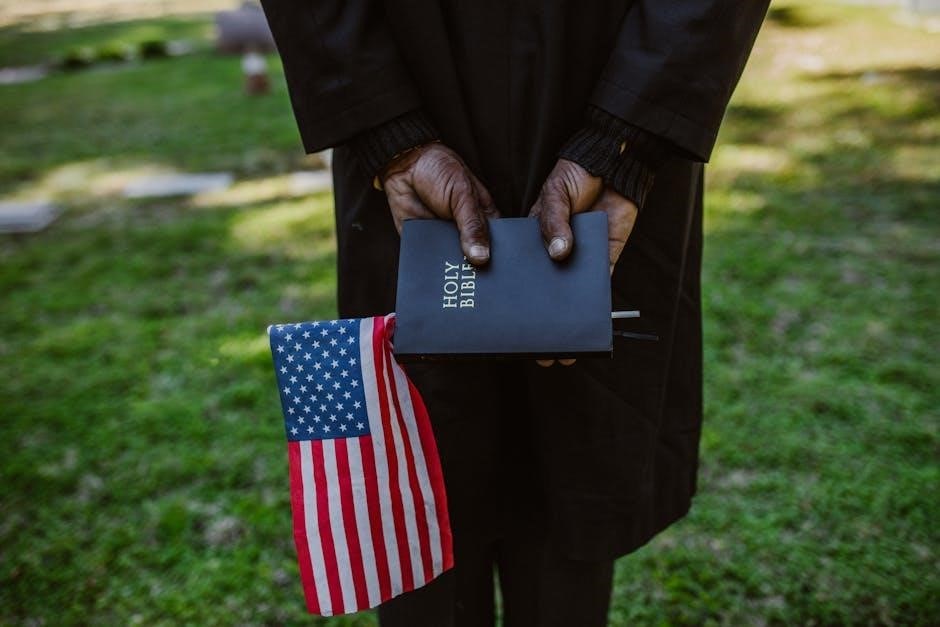
They Called Us Enemy is a powerful graphic memoir by George Takei, recounting his childhood in Japanese American internment camps during WWII. It explores themes of identity, racism, and democracy, offering a poignant reflection on one of America’s darkest chapters.
Background and Significance of the Book

They Called Us Enemy is a graphic memoir co-authored by George Takei, Justin Eisinger, Steven Scott, and illustrated by Harmony Becker. It recounts Takei’s childhood experiences in Japanese American internment camps during WWII, shedding light on a dark chapter of U.S. history. The book serves as a powerful educational tool, blending personal narrative with historical context to explore themes of identity, racism, and democracy. Its significance lies in its ability to make this history accessible to a wide audience, particularly younger readers, through the graphic memoir format. The collaboration between Takei and his team ensures a compelling and emotionally resonant storytelling experience.
Overview of the Graphic Memoir Genre
The graphic memoir genre combines vivid illustrations with personal narratives, offering a unique storytelling experience. It blends visual and textual elements to convey complex emotions and historical events. This format makes challenging topics more accessible, especially for younger audiences. They Called Us Enemy exemplifies this genre, using art to bring George Takei’s experiences to life. The collaboration between writers and illustrators creates a powerful medium for sharing personal and historical truths, fostering empathy and understanding. The graphic memoir has become a popular way to explore identity, trauma, and social issues, making it a vital tool for education and cultural reflection.
Historical Context of Japanese American Internment
During WWII, Japanese Americans were forcibly relocated to internment camps due to fear and prejudice, following Executive Order 9066. This period marked a dark chapter in U.S. history.
The Events Leading to World War II Internment
The internment of Japanese Americans during WWII was driven by fear and prejudice, exacerbated by the attack on Pearl Harbor in 1941. Executive Order 9066, signed by President Roosevelt in 1942, authorized the forced relocation of over 120,000 Japanese Americans to internment camps. This decision was fueled by wartime hysteria and racial bias, despite a lack of evidence of espionage or disloyalty. The U.S. government and military leaders framed the action as a necessary security measure, but it disproportionately targeted innocent civilians, including women and children. The War Relocation Authority oversaw the camps, uprooting families and causing immense emotional and financial hardship. This dark chapter in American history remains a stark reminder of the dangers of fear-driven policies.
Life in the Internment Camps
Life in the internment camps was marked by harsh conditions and emotional turmoil. Families were forced to live in cramped, poorly constructed barracks with limited privacy and inadequate facilities. The camps, often located in remote, inhospitable areas, lacked basic amenities, leading to overcrowding and health issues. Despite these challenges, many internees attempted to create a sense of normalcy, organizing schools, community events, and religious services. However, the psychological toll of confinement and the loss of dignity weighed heavily on individuals and families. The experience shaped George Takei’s perspective on resilience and injustice, as depicted in his memoir, offering a vivid portrayal of life behind barbed wire.
Impact on Japanese American Families
The internment of Japanese Americans during WWII caused profound emotional and financial devastation for families. Many lost their homes, livelihoods, and savings, leaving them with nothing upon release. The trauma of forced relocation and confinement led to psychological scars, including anxiety, depression, and intergenerational pain. Families were separated, and children grew up in an environment of fear and uncertainty. Despite these hardships, many found strength in their cultural heritage and community bonds. The experience shaped their resilience and identity, as explored in They Called Us Enemy, highlighting the human cost of wartime hysteria and its lasting effects on Japanese American families for generations.
George Takei’s Personal Narrative
George Takei’s memoir shares his childhood in WWII internment camps, detailing his family’s resilience and the profound impact on his future activism and identity formation.
Takei’s Childhood Experiences in the Camps
George Takei’s memoir vividly recounts his childhood in WWII internment camps, where he was forcibly relocated at age four. The camps were stark, with barbed wire and harsh conditions, yet his family’s resilience shone through. His father’s unwavering faith in democracy and his mother’s tough decisions shaped his early understanding of injustice. These experiences left an indelible mark on Takei, influencing his future activism and quest for equality. The memoir captures the terror and joy of growing up in such an environment, offering a deeply personal and historical perspective on a painful chapter of American history.

The Role of Family and Resilience
In They Called Us Enemy, George Takei highlights the pivotal role of his family during the internment. His father’s unwavering faith in democracy and his mother’s courageous decisions provided strength amid hardship. Despite the harsh conditions, the family’s unity and resilience helped them navigate the challenges of legalized racism. Takei’s parents instilled in him a sense of hope and justice, which later fueled his activism. The memoir underscores how familial bonds and resilience not only sustained them but also shaped Takei’s identity and future. Their story serves as a testament to the power of family in overcoming adversity and fostering hope.
How the Internment Shaped His Future
The internment experience profoundly shaped George Takei’s future, fueling his advocacy for justice and equality. The hardships and injustices he endured as a child instilled in him a deep commitment to fighting prejudice and promoting human rights. His journey from the camps to becoming a celebrated actor and activist was driven by the lessons of resilience and hope learned during those formative years. Takei’s experiences influenced his career choices, including his role in Star Trek, where he championed diversity and representation. The internment also inspired his activism, as he sought to ensure that such injustices would never recur, aligning with the book’s themes of democracy and resilience.
Themes Explored in the Book
They Called Us Enemy explores themes of identity, belonging, racism, and resilience, highlighting the challenges of democracy and the enduring power of hope.
Identity and Belonging

In They Called Us Enemy, George Takei delves into the struggle of identity and belonging faced by Japanese Americans during WWII. The memoir vividly portrays the internal conflict of being caught between two cultures, as Takei and his family navigated the harsh realities of internment. The book explores how the forced relocation and racial discrimination led to a crisis of identity, questioning what it means to be American. Through personal anecdotes, Takei illustrates the tension between cultural heritage and national loyalty, shedding light on the enduring quest for belonging in a country that once rejected them.
Racism and Prejudice
They Called Us Enemy vividly portrays the racism and prejudice faced by Japanese Americans during WWII. George Takei recounts how racial hysteria led to the internment of over 120,000 people, including children like himself. The memoir highlights the dehumanizing conditions and the psychological toll of being treated as enemies solely due to their heritage. Takei’s experiences illustrate the deep-seated prejudice that fueled the internment, as well as the lasting scars it left on families. The book serves as a powerful reminder of the dangers of unchecked racism and the importance of confronting such injustices to prevent their recurrence in the future.
Resilience and Hope
They Called Us Enemy underscores the resilience and hope that sustained George Takei and his family during their internment. Despite the harsh conditions and racial injustice, Takei’s father maintained faith in democracy, while his mother made difficult choices to protect their family. The memoir highlights how these experiences, though traumatic, shaped Takei’s future as an advocate for justice and equality. Through his story, Takei conveys the power of hope and the human spirit’s ability to endure and overcome adversity. The book serves as a testament to the strength of families and communities in the face of oppression, inspiring readers to reflect on resilience and its transformative power.
Democracy and Its Challenges
They Called Us Enemy explores the tension between the ideals of democracy and the realities of injustice. George Takei’s father, despite being imprisoned, remained steadfast in his belief in American democracy, even as the nation failed to uphold its principles. The memoir highlights the contradictions of a country that espoused freedom yet interned its own citizens based on race. Takei’s experiences underscore the fragility of democracy and the importance of holding it accountable. The book challenges readers to reflect on the ongoing struggle for equality and the responsibility of citizens to ensure that democratic ideals are truly upheld for all.

The Collaborative Process
They Called Us Enemy was created through a collaborative effort between George Takei, co-authors Steven Scott and Justin Eisinger, and illustrator Harmony Becker. Their teamwork brought depth and visual storytelling to the memoir, blending personal narrative with historical context to create a compelling and emotional account of Takei’s experiences.

Co-Authors and Their Contributions
The graphic memoir They Called Us Enemy was co-authored by George Takei, Steven Scott, and Justin Eisinger. Steven Scott, an Eisner Award-winning writer, brought his expertise in storytelling and historical narrative to the project. Justin Eisinger, a seasoned editor and writer, contributed his skills in shaping the memoir’s structure and tone. Together, they collaborated with Takei to transform his personal experiences into a compelling and accessible account. Their combined efforts ensured the book’s emotional depth and historical accuracy, making it a powerful and educational resource. Their teamwork was instrumental in conveying the complexities of Takei’s childhood and the broader implications of the internment camps.
The Role of Illustrations in the Memoir
The illustrations in They Called Us Enemy are a vital component of the memoir, bringing George Takei’s experiences to life. The artwork vividly depicts the harsh realities of life in internment camps, capturing the emotional depth of Takei’s childhood. The visuals not only complement the narrative but also provide historical context, making the story more immersive for readers. The illustrators’ attention to detail ensures that the camps’ conditions, the characters’ emotions, and the broader societal backdrop are authentically portrayed. These visuals enhance the memoir’s impact, allowing readers to connect deeply with Takei’s journey and the historical events that shaped his life and identity.

Reception and Reviews
They Called Us Enemy has received widespread critical acclaim, earning the Eisner Award and becoming a New York Times bestseller. Readers praise its emotional depth and historical significance, while the deluxe edition’s bonus material further enhances its appeal, offering a poignant reflection on democracy and identity.
Critical Acclaim and Awards
They Called Us Enemy has garnered significant critical acclaim, earning the prestigious Eisner Award and becoming a New York Times bestseller. The graphic memoir has been praised for its emotional depth and historical significance, offering a poignant reflection on democracy and identity. The deluxe edition, featuring 16 pages of bonus material, further enhances its appeal, providing readers with additional insights into George Takei’s experiences. The book’s ability to blend personal narrative with broader societal themes has resonated deeply with audiences and critics alike, solidifying its place as a vital work in contemporary literature.

Reader Responses and Cultural Impact
Readers have responded profoundly to They Called Us Enemy, praising its emotional depth and historical relevance. Many found the memoir disheartening yet necessary, highlighting the importance of confronting uncomfortable truths. The book has sparked meaningful conversations about identity, democracy, and justice, resonating with a broad audience. Its graphic memoir format has made it accessible to readers of all ages, fostering empathy and understanding. Educators have embraced it for its ability to teach historical awareness, while the general public has praised its storytelling and cultural significance. The memoir’s impact extends beyond literature, inspiring reflections on what it means to be American and the ongoing struggle for equality.

Educational Value
They Called Us Enemy serves as a powerful educational tool, fostering empathy and understanding of historical injustices. Its graphic memoir format makes it accessible for diverse learners, promoting critical discussions on identity, democracy, and social justice while providing a personal perspective on a pivotal moment in American history.
Using the Book in Educational Settings
They Called Us Enemy is a valuable resource for educators, offering a unique perspective on WWII internment. Its graphic memoir format engages students visually and emotionally, making it ideal for history, literature, and social studies classes. The book can be adapted for various age groups, from middle school to college, to explore themes of identity, democracy, and social justice. Teachers can use it to spark discussions on historical context, personal resilience, and the importance of empathy. The memoir also aligns with curriculum standards for teaching about WWII and civil rights, providing a personal and accessible lens for understanding complex historical events.
Teaching Historical Awareness
They Called Us Enemy serves as a powerful tool for teaching historical awareness, particularly about the internment of Japanese Americans during WWII. The graphic memoir provides a personal and emotional lens through which students can understand this dark chapter of American history. By sharing George Takei’s childhood experiences, the book humanizes the broader historical narrative, making it more relatable and engaging for young learners. It encourages critical thinking about democracy, prejudice, and resilience, while fostering empathy and understanding. The memoir is suitable for various educational levels, from middle school to college, and can be integrated into history, literature, and social studies curricula to enrich students’ grasp of the past and its relevance to contemporary issues.

Availability and Formats
They Called Us Enemy is available in various formats, including hardcover, paperback, digital editions, and PDF. It can be borrowed from libraries or purchased online.
Digital and Print Editions
They Called Us Enemy is widely available in both digital and print formats. The book can be purchased as a hardcover, paperback, or eBook, including a PDF version. A deluxe edition, released with 16 pages of bonus material, offers additional insights into George Takei’s experiences. Digital copies are accessible through platforms like libraries, where readers can borrow the book for a limited time. The PDF version is also popular for its convenience and portability, allowing readers to engage with the memoir on various devices. This accessibility ensures that Takei’s story reaches a broad audience, making it easy for readers to explore this critical chapter of American history.
Accessibility and Distribution
They Called Us Enemy is widely accessible in various formats, ensuring its reach to diverse audiences. The book is available as a digital download, including a PDF version, which can be accessed on e-readers, tablets, and smartphones; Print editions, such as hardcover and paperback, are distributed through major bookstores and online retailers. Libraries also offer digital copies for borrowing, making it convenient for readers to access the memoir without purchasing. Additionally, the deluxe edition, featuring bonus material, is distributed across multiple platforms, further enhancing its accessibility. This broad distribution ensures that George Takei’s powerful story is easily attainable for readers worldwide, fostering a wider understanding of its historical significance.
They Called Us Enemy is a testament to resilience, offering a powerful exploration of identity, democracy, and the enduring impact of historical injustices. It reminds us of the importance of remembering and learning from the past to foster empathy and action toward a more equitable future.
Legacy of the Book
They Called Us Enemy has left an indelible mark on literature and history, becoming a vital resource for understanding the Japanese American internment. Its raw honesty and emotional depth have resonated widely, earning it critical acclaim and numerous awards, including the Eisner Award. The book’s legacy lies in its ability to educate future generations about a dark chapter in American history while inspiring conversations about identity, democracy, and justice. By sharing his personal story, George Takei has created a timeless work that fosters empathy and advocates for human rights, ensuring that the lessons of the past are not forgotten.
Future Impact on Society
They Called Us Enemy will continue to serve as a vital educational tool, fostering dialogue about justice, equality, and democracy. Its unflinching portrayal of injustice will inspire future generations to reflect on historical mistakes, promoting empathy and understanding; By sharing George Takei’s story, the book encourages readers to advocate for human rights and stand against prejudice. As a widely acclaimed memoir, it will remain a cornerstone in discussions about identity and resilience, ensuring that the lessons of the past are not forgotten. Its impact will endure, shaping a more informed and compassionate society for years to come.